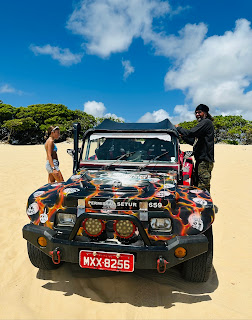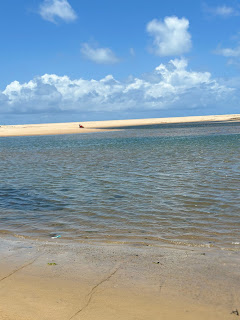Giggio and Mary enjoying Natal's warm weather from the hotel room balcony.
Ok, we are well rested and ready to not waste any time in this paradise.
Rio Grande do Norte is known for it's long coast, with 400 km of white san beaches, and the sand dunes parks. The most popular tour here is the buggy on the dunes.
FROM: https://www.natalriograndedonorte.com/natal-buggy-tours/
The traditional north coastline trip involves a ferry crossing on the Potengi River and continues to Genipabu where you can experience a unique camel ride or a speedy slide down the sand slopes on a board. You will afterwards be floated with the buggy across another stream on a small raft. You will then be taken to Jucumã beach where you can go swimming in lagoon or plunge into the waters via an aerobunda.
Genipabu is used for "buggie" and formerly dromedary rides. Camel rides on the dunes were popular for many years, but as of 2020 they are no longer available. A sport that is played in the dunes around the lake is the "esquibunda", in which a person slides the dunes with a wooden board.
"Buggie" rides are offered locally in two styles, com emoção (lit:'with emotion': a riskier ride) or sem emoção (lit:'without emotion': a safer one). One should be aware, however, that only authorized professionals responsible for security of both tourists and environment should be hired.
The dunes of Genipabu are movable, because the hard winds in the Rio Grande do Norte coastline moves the sand from one point to another, shaping the landscape.
We had the best buggy driver ever. He's name is Robério, but everyone knows him as Caveirão (Big Skull, in English). He is a pioneer in this kind of tours and have been doing it for over 30 years. Caveirão was super careful and kind with the kids, who loved his driving "with emotion".
The camels are not native species from the region, but someone had the "brilliant" idea (sarcasm here) of bringing the poor animals to live here and make some money. After all, who doesn't want to feel like in the Sahara, even in South America??? Obviously, the kids fell into the trap... and we've got a photo to prove it.
A nice break for a swim in the ocean, before we get more into the dunes park. The water temperature is as warm as the outside air. It feels like a hot tube for us.
This is one of my favourite parts. A coop of local men help making the crossing here.
No bridges, nor motors; only their own strength.
The car gets on these floating boats and a man paddles to the other side.
They share all the profits of the business in Praia da Barra do Rio.
No big tourism companies exploring the crossing here.
Next stop is the Lagoa de Pitangui.
It was short but sweet, and the girls had their first jump in the water from a zip-line.
Introducing the Cashew fruit.
Not to many people know that the cashew nut come from a fruit called cashew (cajú, in Portuguese). Each fruit gives ONE nut. The nut comes from a very toxic part of the fruit, the little hook on the top. The extraction process of the nut is long, expensive, hard work and fascinating.
If you want to learn more about the hard process of getting ONE nut from ONE fruit, I recommend this 8 minute documentary called "Why Cashew Nuts Are So Expensive" by Insider Business: https://www.youtube.com/watch?v=CXTZVKYYyig
People can spend the day here enjoying the lagoon, bar and restaurant.
It's like a private beach club, perfect for children.

Back in the Buggy and hitting the dunes.

The driving is full of "emotion", as locals call the crazy maneuvers.
This next stop was the cherry on the top.
Caveirão, our tour guide, says he brings special guests here. Since we came recommended by one of his most loyal clients, we also got a VIP treatment.
Thanks, Michelle!
This is a secret spot called Rio Pratagi, where most of tourists doing the dunes tours don't come.
Locals prepare lobsters of cheese kebabs, freshly squeezed native fruit juices and cocktails.
Good price and excellent service!

Normally, the improvised bar is open only on weekends, unless Caveirão phones them before and let them know special guests are coming, which was the case today. :)
The tour continues and we do crazy things: skibunda (sliding down the dune hill on your butt), tobogganing into the water and zip-line. Here is when my Canadian side spoke out and wondered "is this really safe for the kids???" My Brazilian side said "they will be fine" and off they went down the hill hanging about 10 feet in the air, into the water. Well, that's what they were supposed to do... but since the girls were too light, their butt never touched the water. Instead, they were instructed to jump. They did, and someone yelled: "do you know how to swim???" AFTER!

Being pulled from the water up the hill - after waiting for 10 minutes to fill up the home made motor car with gas.

Morro de São Paulo (São Paulo Dunes Hills, in English).
Here is where the craziest maneuvers happen with the buggy. That's also the end of the radical tour.
This is a "taipa house", a typical house of the sertão area in Brazil. It's made with pieces of wood sticks and mud, the only material available. Multigenerational families live in houses like this one. This is just a model, being built by someone who grew up in one of these houses in the inland - sertão.
Praia de Muriu.
I feel really lucky and special to end up in this place. There was no tourist around, beside us, and we had the large and serene beach all for ourselves. Again, a Caveirão's treat for special guests.

Caveirão's buggy and our friend for the day.

We had a simple but delicious meal at this small local restaurant: sea food for the girls and I and someone else for Mike - the allergic one.
This. Is. Peace.

I love how restaurants here have hammocks for people to take a siesta after lunch.

Hiding back to Natal, in style.

Crossing again, with the men's power.

No bridge, no loud motor ferry, a tranquil crossing.

Arriving back in Natal in the end of the day.
Exhausted but fulfilled, crossing the Ponte Nilton Navarro.
FROM WIKIPEDIA:
The Newton Navarro Bridge, is one of the biggest cable-stayed bridges in Brazil. It is located in the city of Natal, the capital of the Brazilian state of Rio Grande do Norte. It connects North Zone and the cities of the north coast to the South Zone and the other regions of the city that cross the Potengi River.
The main purpose is to ease the usual heavy traffic on Igapó Bridge and to improve access to the future Greater Natal International Airport and its adjacent areas. It also increases the flow of tourism on the north coast and improves access to the inhabitants of the North Zone to the downtown and the main zones.
Back in the hotel : Caveirão and Caveirinha, or Big Skull and Little Skull.

Dinner was very special at the Manary Hotel and Restaurant.
It's a super fancy local place, with lots of colours and character. We tried to stay at this hotel, but it was fully booked. We enjoyed a fantastic time, though, with our lovely friends from Natal.
https://manary.com.br
Manary Praia Hotel
Part of the prestigious Associação Roteiros de Charme, the Manary is an exclusive hotel, located by the sea on the sands of the beautiful Ponta Negra Beach. Its romantic atmosphere, exquisite cuisine and setting – which combines tradition and style – make it the ideal option for those traveling for leisure or business. Neocolonial architecture with antiques found in old farms and mills in the region, with works of art and crafts by renowned artists from the Northeast.

I love these two!
Michele and Sandrinho are amazing souls who Covid kept apart from us way too long.

The food was delicious - a sophisticated local cuisine.
Great gastronomic experience.

The stylish girls!!

A family photo to seal this amazing day!





















































No comments:
Post a Comment